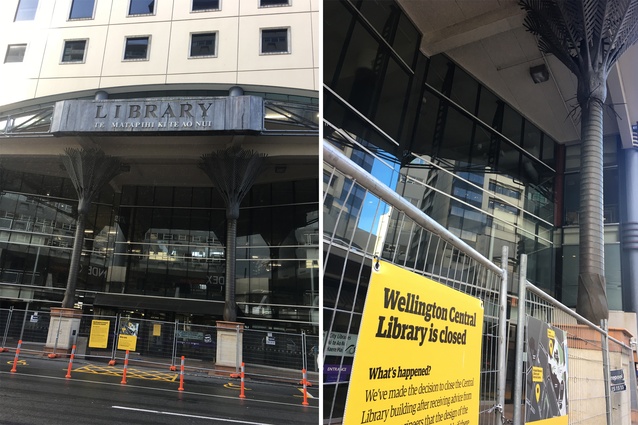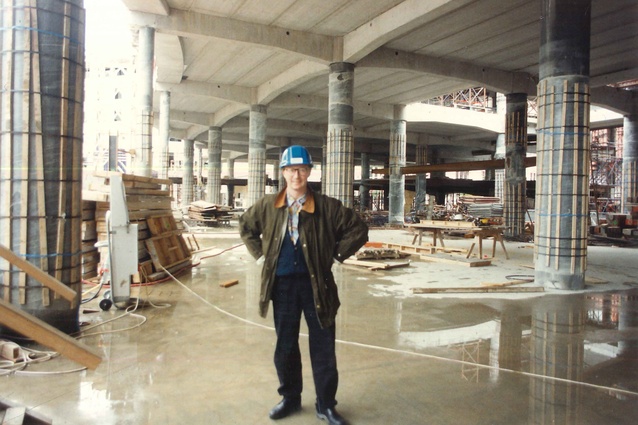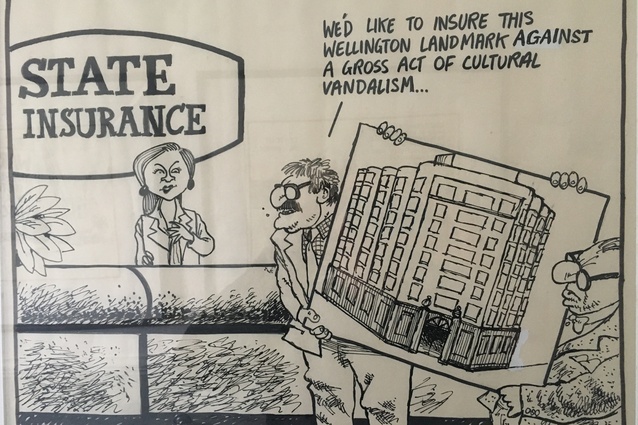Scrap it or save it… again
Ken Davis makes a plea for the retention of the Wellington Public Library and Civic Centre on which he worked as a project architect from 1987 to 1992.
I started my first job out of architecture school at Athfield Architects, one month after the 1987 share market crash, working on the design of the new Wellington Civic Centre and Central Library. My boss was Ian Athfield or “Ath”, the “enfant terrible” of New Zealand architecture. I worked with Ath and a group of 30 talented architects and designers in offices located in his famous house, that extraordinary cluster of buildings clinging to the side of its Khandallah hillside, overlooking Wellington’s harbour.
By the time I joined the office in 1987, Ath had been drawn into the new corporate world unleashed in New Zealand by Rogernomics and the neo-liberalism that was infecting the world like a viral pandemic. Post-Modernism was its architectural emblem and it was all the rage.
Ath, an architectural chameleon, embraced Post-Modernism, more than others, as an opportunity to enrich and explore his architectural form-making and narrative. The iconic metal nikau palm trees that adorn the library building, now a symbol of Wellington, are a legacy of Ath’s trip with fellow architect Rewi Thompson to Los Angeles, to collaborate with internationally acclaimed “starchitect” Frank Gehry on their short-listed design for the Museum of New Zealand competition in 1989.
It was in this context that the Wellington Central Library and Civic Centre was created. The library was Ath’s first commission for a major public building and, while a fine example of Post-Modern architecture with its classical references and idiosyncratic whimsy and visual games, the building does not represent the private and corporate interests that this movement symbolised. Ath subverted the Post-Modern programme and created a public building that is civic, open, generous and accessible. The building presented the modern public library in a new way. No longer stuffy, bookish and deathly silent, it was dynamic, flexible, inclusive and hi-tech – a “factory for books”, as Ath liked to describe it.
It also offered a range of other innovations, such as the first bi-lingual signage and first parenting room in a public building in New Zealand and first café in a public library in Australasia. Upon its opening at the end of 1991, it was universally applauded and became loved because it was a building “of the people, by the people, for the people”. It epitomised Ath’s essential humanity and, in its first year, welcomed over one million citizens.
Ath’s design approach focused on the space between buildings and the library’s positioning on the site was integral to the success of the Civic Square, a space designed for public gathering, celebration, and protest.
In March last year, the library building was suddenly closed because it was deemed earthquake-prone, even though it had survived the 2016 Kaikoura Earthquake without any damage. Almost immediately came calls from politicians, including the former Mayor Justin Lester, to tear down the library and start again with something flash and new, like Christchurch’s recently opened Turanga library.
The Wellington Central Library is a building of not only considerable architectural and urban design significance but a building which attracted over 3000 people per day (1.1 million per year) or approximately 32 million visitors since it was first opened at the end of 1991. It has become known as “Wellington’s living room” and so, immediately, there was public resistance to the then mayor’s calls for demolition.
In July last year, the NZIA undertook the successful “Save it or Scrap it” campaign to help advocate for the building. At a packed public meeting of over 300 at the National Library auditorium, local structural engineer Adam Thornton, famous for moving the Museum Hotel to allow the construction of Te Papa, proposed a possible solution. Having undertaken analysis of the building’s structure, Thornton presented a pragmatic, cost-effective, staged solution for the building’s seismic upgrade.
The solution included a low-cost, quick-fix option to address the problem of the precast concrete Dycore floor slabs – bolting 100 x100 steel angles to the sides of the beams to increase the floor slab seating from 50mm to 150mm. It was estimated to cost $10 million and to be completed in 6 to 10 months.
This would lift the building well above the 34 per cent New Building Standard (NBS) threshold needed to make the building safe for re-opening. Thornton advised to then “take a breath”, pay for the Town Hall and the St James upgrades and come back in 10 years and complete the rest of the building. That second upgrade would include full base isolation, costing about $30 million and taking about 3 to 4 years.
The NZIA campaign proved effective, with the fate of the building becoming a local body election issue and resulting in a mayoral commitment to re-evaluate the original structural assessment that triggered the building’s closure.
In May this year, a new structural report was released, including assessments to upgrade the library building. This prompted renewed calls from local body politicians, including the newly elected mayor, for the library’s demolition and replacement with a new building “fit for the 21st century”.
This was challenged on June 3 at another council meeting, by a range of respected advocates: architect Roger Walker, Adam Thornton, former Wellington Deputy Mayor Helene Ritchie and Scoop editor Lindsay Shelton. As a result, Council decided to put further decisions to demolish on hold and to review other options to retain the building in more detail. After further deliberations, on June 10, Council voted 14-1 to retain and upgrade the building.

On July 21, council officers released more detailed options and timelines for the library building. These also included proposals to upgrade building services and the interior fit-out and improve the building’s integration with Te Ngakau Civic Square.
The four options, released for public consultation on July 27, were:
• Low-level remediation ($76.3m–$90.8m)
• Mid-level remediation ($131.2m–$151.8m)
• New build on the same site ($156m–$160.7m)
• New build on another Te Ngakau Civic Precinct site ($156m–$160.7m)
Other recommendations from council officers included a disquieting and unimaginative proposal to privatise the library, proposing developers “could buy the building, upgrade it, and lease the land back to the Council.” The mayor and some councillors immediately hit back, challenging this advice and the proposal was rejected.
Despite this internal political dissonance, Council should be compelled by Thornton’s intelligent, pragmatic, quick-fix and cost-effective proposal (presumably incorporated into the Low-level remediation option). In the face of a looming Covid-19 budget shortfall, while searching not only for operational and capital savings but also cost-effective projects that might fit with the government’s post-Covid infrastructure spend on “shovel-ready” projects, it seems eminently sensible.
And, as both central government and the Council look for these types of projects, the most cost-effective and quickest projects to get underway are those that increase the earthquake, climate change, sustainability and Covid-19 resilience of Wellington’s existing building stock. The retention and upgrade of the library and Civic Centre definitely falls into that category of “shovel-ready”.
Getting the building open to the public sooner rather than later, and the human and commercial activity that will be generated by its reopening will also be important in helping the commercial and emotional recovery of a CBD currently languishing from the effects of the Covid-19 shutdown. Also worth considering is the cost to Council of its current commercial leases for three temporary CBD library pop-ups plus a new Johnsonville library collection and distribution centre, likely costing $1–2 million per year in rents alone while the existing Wellington Central Library stands empty.
Good architecture is robust, flexible, resilient and enduring and the Wellington library building is all of those things. As part of the 1990’s Civic Centre development, the 1930’s former library building was successfully converted to a contemporary public art gallery and the 19th-century Old Town Hall was upgraded to a state-of-the-art concert hall. So, too, can the library be tweaked, modified and modernised to respond to the needs of a 21st-century library.
It was back in 1989, in the midst of the recession following the 1987 share market crash, that the Wellington City Council committed to proceed with construction of the Wellington Civic Centre project. The largest construction project in New Zealand at the time, it stimulated and sustained the Wellington construction economy at a time when it was needed. This was a fine example of a local council providing fiscal stimulus when both the Labour and National governments of the time chose austerity, with its consequential catastrophic effects on the national economy.
Despite the resulting economic fallout and the subsequent recession, a re-imagined, dynamic, smart and vibrant “Absolutely Positively Wellington” emerged, inspired by its new library and Civic Centre. Since then, Wellington City has continued to develop and innovate and is now one of the best “boutique” cities in the world.
It is also important to re-state the significant environmental cost associated with destroying the building, especially given its demolition would be inconsistent with Wellington City Council’s own sustainability policy Te Atakura – First to Zero. Angela Foster (NZIA Wellington Branch Chair) raised this issue in her opinion piece, “Wellington library building more than just bricks and mortar”, in The Dominion Post in June last year:
“Knocking down the library would be like ripping out a chapter in a book. The removal of the building will leave a hole in the city’s heritage. It will do something else, too: incur an inevitable environmental cost,” wrote Foster.
“Construction produces nearly 40 per cent of energy-related carbon dioxide emissions and it takes decades for a new building to compensate for the negative climate change effects resulting from its construction. This should be of concern to the council. Why? Because it has just released Te Atakura – First to Zero, its blueprint for “a zero-carbon capital city”.
Given the library building’s popularity, Council should not under-estimate the potential groundswell of public support to save the library building. Any attempts to destroy the building, which not only holds great public meaning and value but forms a key part of an important Civic heritage precinct, could result in a prolonged delay from public protest and legal challenges.
However, despite the political reassurances and proposals for community engagement, the building’s fate is still at risk. Highlighting this risk, Wellington property developer Richard Burrell recently made an application to Heritage New Zealand for the library building to be given a heritage classification.
We now await the ruminations of this government agency, knowing full well such classifications can offer no protection at all – as demonstrated by the 2016 destruction of the John Scott-designed Visitor Centre at Aniwaniwa near Lake Waikaremoana. That despite vigorous protests from the architectural community and the building’s classification as a Category 1 Historic Place. The library’s only real protection is a Heritage Listing on the Wellington District Plan, which it currently does not have.
New Zealand society’s approach to architecture and architectural heritage is like our culture – prosaic, pragmatic and unsophisticated. This seemingly deep-seated national trait is underpinned by a notion of destruction and wanting to start over with a clean slate.
Ath, both fêted and hated, was one of New Zealand’s most significant architects, possibly our most significant. His extraordinary body of work, from bespoke houses, apartment buildings, schools and office buildings to public buildings and civic spaces, is unrivalled in New Zealand. He is our architectural genius, the Antonio Gaudi of the South Pacific.
As I begin the last decade of my career as an architect, it is in the context of yet another international economic crisis and the seemingly relentless challenge to our architectural heritage, underscored by the current threat to the Wellington Central Library.
To destroy this “living room of our city” would be a “gross act of cultural vandalism”.* The citizens of Wellington and the New Zealand architectural profession cannot let this happen and must remain vigilant.
* Quote created and used by Ken Davis as part of the Wellington Architectural Centre’s successful 1989 campaign to save Gummer and Ford’s 1939 State Insurance Building and used in one of Tom Scott’s three cartoons as part of that campaign.












